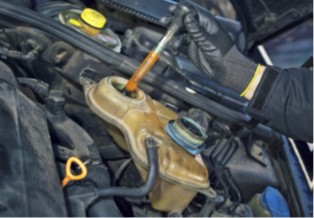乙二醇
乙二醇
概述
因为乙二醇具有出色的传热能力,所以液冷发动机和旋转设备常使用基于乙二醇的冷却剂。然而,基于乙二醇的冷却剂在润滑油领域却很不受欢迎,因为泄漏进润滑剂的冷却液是一种特别令人讨厌的污染物,它可能对设备造成各种损坏

乙二醇冷却剂在发动机的高温环境中分解,形成乙醇酸。这些酸会侵蚀有色金属轴承表面并形成金属盐。酸还与油中的抗磨和抗氧化添加剂发生反应,并与水一起产生堵塞过滤器的污泥,导致油失去其润滑性能,从而加剧磨损。发动机和变速器中的乙二醇污染被认为是比单独的水污染更严重的污染物(破坏性高达10倍)。油温不同,乙二醇冷却剂可能会迅速分解或随着时间的推移而缓慢分解。这种不稳定性是确定给定时间油里实际的乙二醇含量的主要挑战,也是现场和实验室测试结果经常不一致的主要原因。
Cummins的实验室测试结果表明,“含有4%冷却液的机油在200°F(93°C)的温度下加热8小时后,只会保留10%的乙二醇。然而,能表明污染情况的乙二醇污染的其他迹象仍保留在油中。
乙二醇污染检测方法
►红外光谱
红外光谱常用于实验室或现场,可以检测一系列分子污染物和润滑剂化学降解参数。红外光谱使用红外辐射源,样品架,探测器和计算机来研究物质与光的相互作用。来自各种化合物的分子以有特征,可重复的频率振动,因此特定区域的频谱扫描将指示目标污染物的性质和浓度。乙二醇在对应O-H官能团的3450 cm-1附近区域具有较强的吸收带,并且在对应于C-O官能团的1070-1030 cm-1区域处具有更独特的乙二醇吸收带。水和添加剂的干扰会导致测量误差,因此需要对信号进行大量的处理来确保产生一致且可靠的结果。
既有用于实验室级也有用于便携式现场测试的FTIR测量方法。ASTM E2412是FTIR测量常见发动机机油中降解产物和污染物(包括乙二醇)的标准。在该标准中,15ml油样会通过自动系统被泵送到采样池中进行测量。在检测下一个油样前,需要用庚烷冲洗系统。
为了在现场监测石油化学成分,ASTM D7889使用像FluidScan这样的光栅红外光谱仪,该仪器易于操作,不需要经验丰富的技术人员。便携式FluidScan使用具有专利的翻盖式光学池,该光学池仅需几滴油即可完成分析。清洁翻盖池无需溶剂。可以使用干净的布或一次性擦拭布擦拭。
► 原子发射光谱
多年来,通过电感耦合等离子体(ICP)发射光谱或电弧火花旋转圆盘电极(RDE)发射光谱进行元素分析一直是油品分析实验室的标准做法,详见ASTM D5185和ASTM D6595。元素分析是一种用于验证乙二醇是否已经进入润滑油的非常可靠的方法,因为冷却剂的痕迹会保留在油中,特别是金属有机腐蚀抑制剂,它们在乙二醇冷却剂中的浓度很高,但并不是原本油配方中的成分。通常将钠、硼、钾和硅添加到冷却剂中以抑制腐蚀。RDE方法将油样直接倒入盖子中,并将新的石墨盘电极和棒电极引入腔室并通电。在大约一分钟内,将出现通常24至30种元素的分析结果,以及与新油样品对比的添加剂值。一家大型发动机制造商认为,机油中的钠增加50 ppm可能意味着已经有一加仑的冷却液泄漏到10加仑(38升)润滑油系统中。
► 吸墨测试
将一张普通的吸墨纸放在平坦的表面上,用量油尺在纸的中间滴上几滴油,然后放置一个小时。如果油滴向外扩展,并留下具有黄色/棕色中心的“烟灰环”,则表明油中存在乙二醇。这是一个简单的通过/不通过测试,是乙二醇污染的常见表现。具有清晰(锋利边缘)外围的黑色粘性糊状物需要引起重视。当乙二醇存在时,“烟灰环”经常在黄色/棕色中心周围形成。
► 希夫试剂法(GLY-TEK试剂)
最著名的乙二醇快速测试方法可能是希夫试剂法(ASTM D2982)。这是一种基于比色的方法,用于检测润滑油中存在的微量乙二醇。这种方法会将油样移液到盐酸(HCl)和碘酸(HIO3)的溶液中,以氧化可能存在的乙二醇。然后再将溶液移液到玻璃管中,以便更好地观察。该反应产生醛,醛又与希夫试剂反应,产生从无色到粉红色/紫色的颜色变化,颜色越深,表明油样中的乙二醇就越多。
► 气相色谱
乙二醇分析中最常用的GC标准是ASTM 4291,《废机油中微量乙二醇的标准试验方法》。该过程首先用水从油中提取乙二醇,然后离心。将提取物注入色谱柱中,通过火焰电离检测器(FID)检测洗脱化合物并报告。气相色谱(GC)也可用于分析,但乙二醇由于其低分子量,低挥发性和高极性而难以被检测和定量分析。乙二醇色谱峰的形状通常难以控制,残留也可能是一个问题。
总结
乙二醇是一种破坏性很强的污染物,当用于发动机或旋转设备的传热任务时,必须对其进行监测。油中乙二醇的检测有几种直接和间接的方法,可能需要多种方法来确定是否真的出现问题。
获取免费电子指南并了解更多信息
下载电子指南
